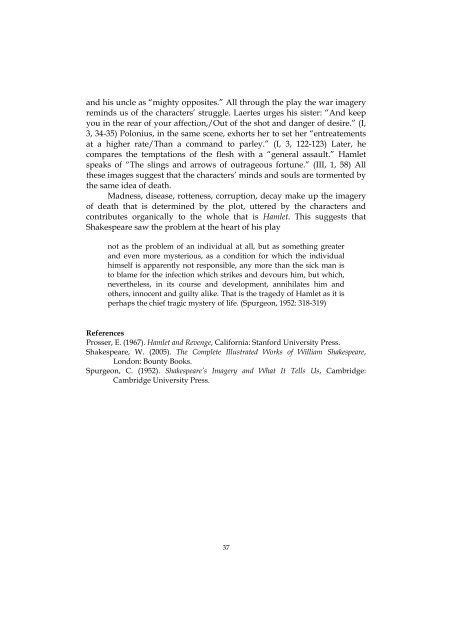translation studies. retrospective and prospective views
translation studies. retrospective and prospective views
translation studies. retrospective and prospective views
You also want an ePaper? Increase the reach of your titles
YUMPU automatically turns print PDFs into web optimized ePapers that Google loves.
<strong>and</strong> his uncle as “mighty opposites.” All through the play the war imagery<br />
reminds us of the characters’ struggle. Laertes urges his sister: “And keep<br />
you in the rear of your affection,/Out of the shot <strong>and</strong> danger of desire.” (I,<br />
3, 34-35) Polonius, in the same scene, exhorts her to set her “entreatements<br />
at a higher rate/Than a comm<strong>and</strong> to parley.” (I, 3, 122-123) Later, he<br />
compares the temptations of the flesh with a “general assault.” Hamlet<br />
speaks of “The slings <strong>and</strong> arrows of outrageous fortune.” (III, 1, 58) All<br />
these images suggest that the characters’ minds <strong>and</strong> souls are tormented by<br />
the same idea of death.<br />
Madness, disease, rotteness, corruption, decay make up the imagery<br />
of death that is determined by the plot, uttered by the characters <strong>and</strong><br />
contributes organically to the whole that is Hamlet. This suggests that<br />
Shakespeare saw the problem at the heart of his play<br />
not as the problem of an individual at all, but as something greater<br />
<strong>and</strong> even more mysterious, as a condition for which the individual<br />
himself is apparently not responsible, any more than the sick man is<br />
to blame for the infection which strikes <strong>and</strong> devours him, but which,<br />
nevertheless, in its course <strong>and</strong> development, annihilates him <strong>and</strong><br />
others, innocent <strong>and</strong> guilty alike. That is the tragedy of Hamlet as it is<br />
perhaps the chief tragic mystery of life. (Spurgeon, 1952: 318-319)<br />
References<br />
Prosser, E. (1967). Hamlet <strong>and</strong> Revenge, California: Stanford University Press.<br />
Shakespeare, W. (2005). The Complete Illustrated Works of William Shakespeare,<br />
London: Bounty Books.<br />
Spurgeon, C. (1952). Shakespeare’s Imagery <strong>and</strong> What It Tells Us, Cambridge:<br />
Cambridge University Press.<br />
37












